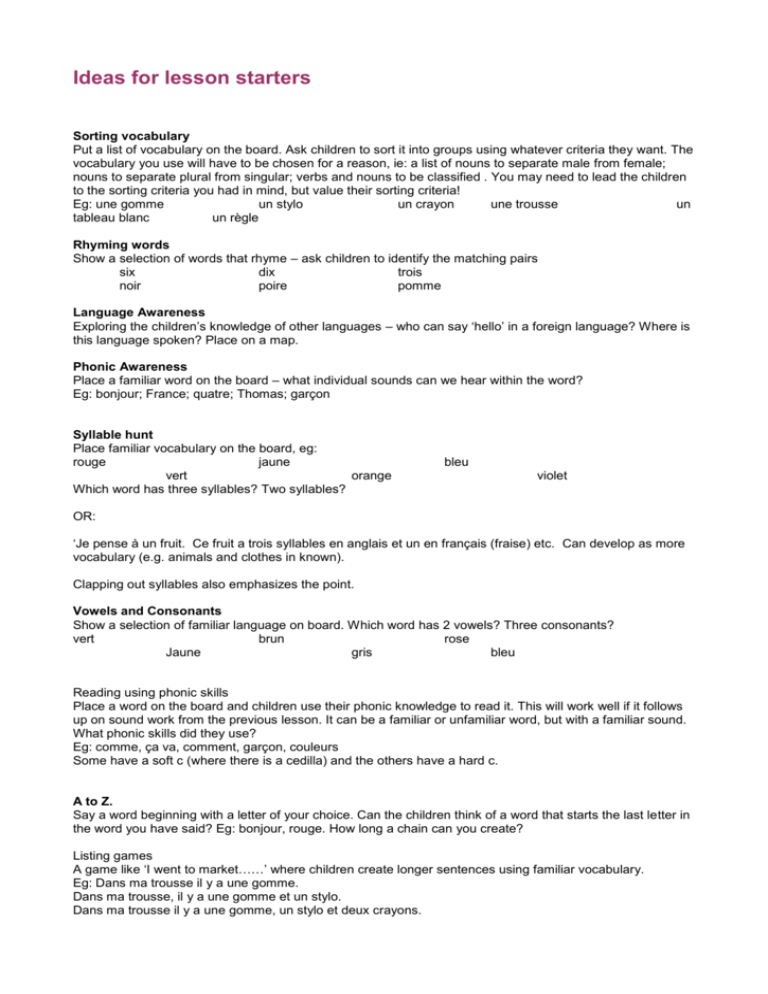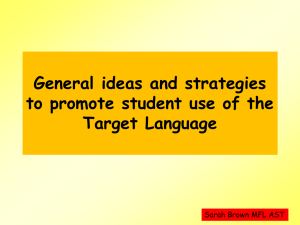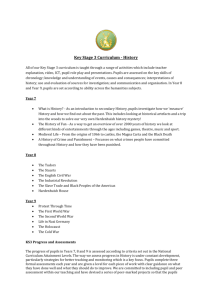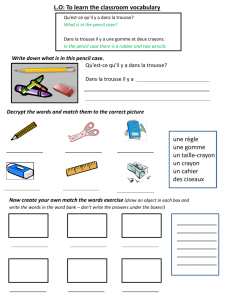starters_and_games
advertisement

Ideas for lesson starters Sorting vocabulary Put a list of vocabulary on the board. Ask children to sort it into groups using whatever criteria they want. The vocabulary you use will have to be chosen for a reason, ie: a list of nouns to separate male from female; nouns to separate plural from singular; verbs and nouns to be classified . You may need to lead the children to the sorting criteria you had in mind, but value their sorting criteria! Eg: une gomme un stylo un crayon une trousse un tableau blanc un règle Rhyming words Show a selection of words that rhyme – ask children to identify the matching pairs six dix trois noir poire pomme Language Awareness Exploring the children’s knowledge of other languages – who can say ‘hello’ in a foreign language? Where is this language spoken? Place on a map. Phonic Awareness Place a familiar word on the board – what individual sounds can we hear within the word? Eg: bonjour; France; quatre; Thomas; garçon Syllable hunt Place familiar vocabulary on the board, eg: rouge jaune vert orange Which word has three syllables? Two syllables? bleu violet OR: ‘Je pense à un fruit. Ce fruit a trois syllables en anglais et un en français (fraise) etc. Can develop as more vocabulary (e.g. animals and clothes in known). Clapping out syllables also emphasizes the point. Vowels and Consonants Show a selection of familiar language on board. Which word has 2 vowels? Three consonants? vert brun rose Jaune gris bleu Reading using phonic skills Place a word on the board and children use their phonic knowledge to read it. This will work well if it follows up on sound work from the previous lesson. It can be a familiar or unfamiliar word, but with a familiar sound. What phonic skills did they use? Eg: comme, ça va, comment, garçon, couleurs Some have a soft c (where there is a cedilla) and the others have a hard c. A to Z. Say a word beginning with a letter of your choice. Can the children think of a word that starts the last letter in the word you have said? Eg: bonjour, rouge. How long a chain can you create? Listing games A game like ‘I went to market……’ where children create longer sentences using familiar vocabulary. Eg: Dans ma trousse il y a une gomme. Dans ma trousse, il y a une gomme et un stylo. Dans ma trousse il y a une gomme, un stylo et deux crayons. Reorganise words within a sentence To practise word order, agreements and revise vocabulary, practise learning skills i.e. using grammatical and punctuation clues) Tell Pupils the context /topic e.g. In the classroom dans un ma crayon trousse j’ai une j’ai gomme stylos et deux Find the odd one out …and explain why (pupils can be encouraged to use grammatical terminology (noun, adjective) or reference to sounds as well as odd one out related to meaning. stylo crayon bleu neuf bleu rouge (is it neuf as a number or rouge because of the sound?) More able pupils could be asked to invent some more for the class Find pairs or families from a random list mardi bleu rouge huit poire bonjour salut stylo crayon lundi pomme fraise au revoir dix Listen and touch Attach a dozen or so flashcards on board (or pictures on IWB / screen) – Pupil volunteer from each of 2 teams. Teacher (or another pupil) calls out item. 1st pupil to touch the item scores a point. Can also be done quite simply (and repeatedly!) with numbers 1-12. Flash card rapping. Getting oral repetition chorally but chanting to a rhythm or tune. Chinese whispers Pupils in rows – First pupil in each row are given a phrase (or a series of numbers) which they whisper to the pupil behind who passes it on to the pupil behind until it reaches the last pupil who has to give the phrase back…..need a different phrase for simultaneous teams. Points are scored if the final message is the same as the original! Run and write Pupils work in pairs – they have a “target text” posted on the classroom wall somewhere (text might be a straightforward e.g. shopping list or people giving their names or some phrases from one of the story books) Pupils take it in turns to go to text and have 30 seconds to read a bit before returning to partner to “dictate” as much as they can remember. Kim’s game Memory games based on the party game where tray of objects is studied for a minute – players close eyes and an object is removed from the tray / or board / or screen – players say or note down what is missing at each round (in pairs for support). Silence! Present some known words or phrases visually and say the words. Pupils repeat in chorus. Then start saying the wrong thing for some of them. If you say the wrong word / phrase, pupils should remain silent. Voices! To revise some known vocabulary, have some pictures to represent silly voices (whisper, grandad, baby, excited, sad etc. and hold these up to direct the style of the repetition. Singalong Use a recorded song with which pupils are familiar. After a few seconds, turn down the sound and pupils (in pairs perhaps) have to continue singing and still be in time and in tune when the volume is turned back up. Games in teaching Modern Foreign Languages Rationale: To have fun, to practise the language, to communicate, to motivate and to develop social skills such as turn taking and working with others. Pairs Ping – pong. An imaginary game of ping pong is played between 2 children, ideal for practising vocabulary with a logical order (days, months, alphabet, numbers), where the next ‘shot’ is what comes next: easily differentiated. Tap and say. A taps the syllables of the word / phrase, B says it out loud. Draw and say. A draws in the air or with finger on desk the word / phrase, B says it out loud Mime and say. A mimes the word / phrase, B says out loud. Pelmanism and Kim’s game (once established these are good pair games, see below) Guessing games. Any game where A has the word or answer and B has 2 -3 chances to guess helps practice the language (and is a form of repetition technique). Eg if practising numbers 1-10: child A has x fingers behind his back, asks “c’est quel numéro?”, child B guesses “trois”. Child A “non, pas correct” so B loses one life. Children can seem disarmingly honest: A thinks of an item, “je pense à un animal”, B guesses. Round the class Teacher models this first, asks a question then throws beachball / soft toy to a child who must answer, child then repeats question and throws to another child. Include target language such as ‘attention’, ‘pardon’, ‘excusez-moi’, ‘doucement’ First pupil says short sentence (eg Sophie: “j’ai un chat”), second adds his information and repeats what he has heard (Max: “je n’ai pas d’animal, Sophie a un chat”)… perhaps stop at 7 pupils, this gets difficult! Adapt this by putting items in a list: eg ‘dans ma trousse il y a une gomme’, ‘dans ma trousse il y a une gomme et un stylo’ and add to the list. Pistons on common sounds. I’ve used for days of the week: lun – di, mar –di, mercre – di etc where children jump up like pistons on sound of ‘di’. Do this against the clock. Stand up /sit down when you hear your number / colour (or other item). Very simple to organise and shows understanding of item being taught. Begin by counting round the group giving sequence of colours or number (or both), eg jaune, bleu, rouge, vert etc Teacher says ‘lève-toi quant tu entends ta couleur’ Team games Though be wary where children might drop out early (elimination games) or where too much excitement is generated about points … Divide class into two teams. Teacher writes numbers (1-10 or 10-20) on board. As teacher calls out a number, a member of each team runs up and rings / rubs out the number. If this gets too boisterous in terms of running, a team member stands at front and rings / rubs out number. Teams can either compete with same numbers or you write two sets of identical numbers and each time marks its half of the board. Simon says –(giving instructions which everyone carries out or not depending on whether you’ve said prefaced the instruction with ‘Jacques a dit’). Here I suggest that when a pupil is ‘out’ they sit but continue to play the game and not to let it go on too long so that there is always a group standing. A variation is to go through a list of instructions, parts of the body, other vocab list in which the teacher deliberately says something wrong. Pupils repeat word / phrase / action if correct but stay quiet (or shout ‘pas correct’) if wrong. Noughts and crosses (Morpion) with 2 teams (les croix et les ronds) competing to complete a line by identifying whatever word / phrase is within the 9 squares. Tip: make sure one team member gives you the correct number in French of the square being answered, and only one pupil is allowed a go in each team (to increase the range of those contributing) -you might allow quick team discussion. Also have a time limit on giving answers: eg (vous avez cinq secondes). Listen and do Can be used for checking understanding of many items. Children may or may not leave their seats (you decide): eg if checking colours: Teacher says “montrez-moi un objet rouge / bleu / jaune” etc and pupils point to one. Variation: “touchez un objet bleu / vert” etc and pupils have to run to touch the nearest correct colour. This works equally with flash cards for words / phrases taught which are quickly blutacked to different walls of the classroom. Once established a pupil can be volunteer teacher to give the instructions. Fruit salad (salade de fruits). This again shows recognition of vocabulary. You need chairs and plenty of space and will already have presented the vocabulary. With children sitting down in a circle (asseyez-vous en cercle!), you number off the pupils in sequence eg un, deux, trois, quatre, un, deux, trois, quatre or give pupils different vocab items eg pomme, banane, fraise, orange, (repeated). Ensure there are several children in each category. Pick a category to swap places: “Tous les numéros trois –changez de place! Les oranges – changez de place!” As pupils swop, you (or pupil volunteer) also takes an empty chair. Someone will be left without a seat and he/she becomes the next caller. Card games Snap, dominoes, snakes and ladders (le jeu des serpents et des échelles) pelmenism -and other memory games- all work in French. Pelmenism. Essentially this is about matching pairs. Cards (with pictures or pictures and words) are placed face down. Players turn over 2 cards at a time hoping to get a match. It is important that pupils say the foreign language word or phrase for the pictures as they turn them. Kim’s game (Jeu de Kim). Can be played with cards, real objects or cut out drawings on OHP or on whiteboard. Teacher shows all the items, runs through them, class repeat. Either cover the items or children close eyes (fermez les yeux) and teacher removes –or covers- one item, then asks: ‘Qu’est-ce qui manque? Again, you might use a pupil volunteer to act as teacher. Recommended reading: Games and fun activities by Cynthia Martin (Number 2 in the Young Pathfinder series, available from CILT, the National Centre for Languages), publications tel: 0845 458 9910.









